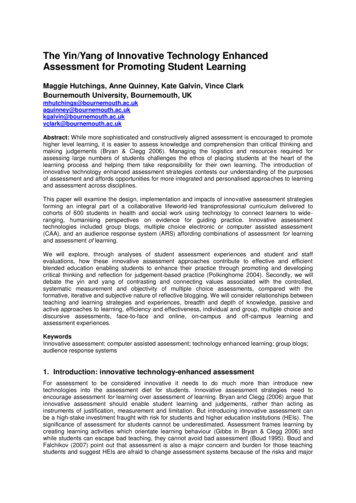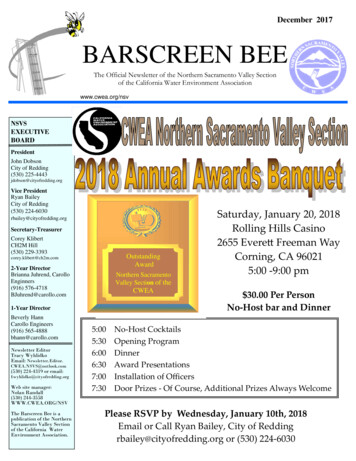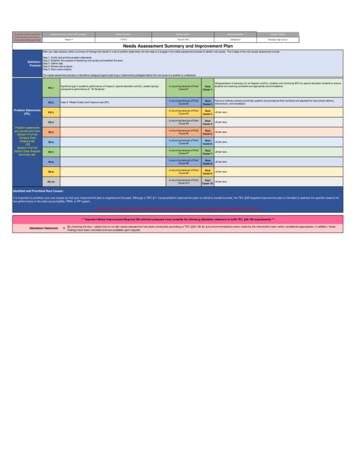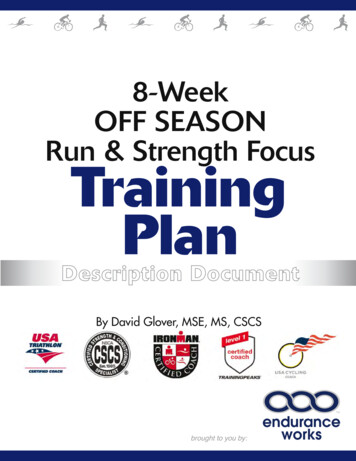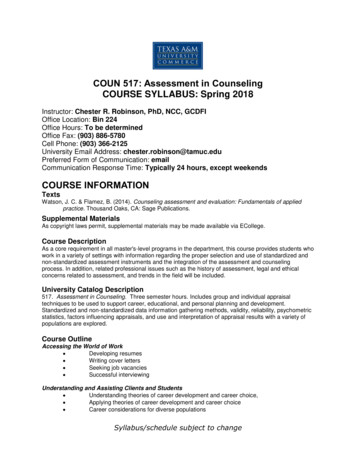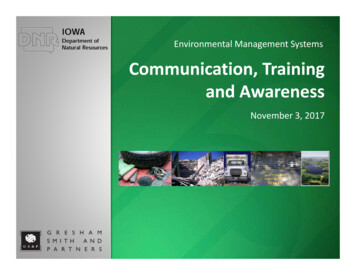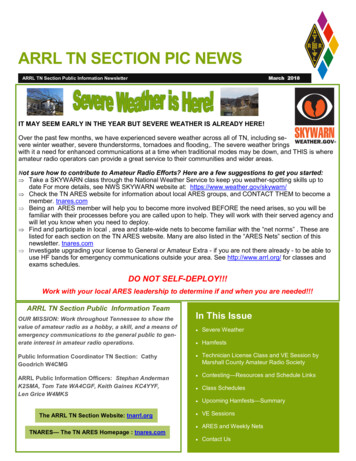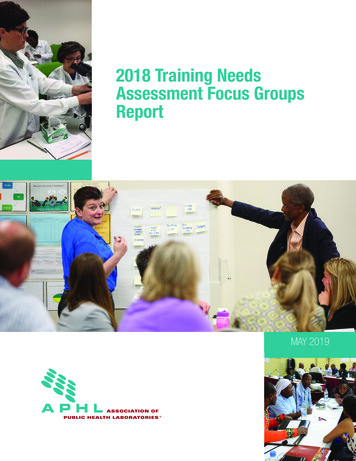
Transcription
2018 Training NeedsAssessment Focus GroupsReportMAY 2019
AcknowledgmentsThe APHL Training and Workforce Development Program would like to thank: eLearning Talent for drafting the initial report APHL Institutional Research Program for their assistance in data collection APHL Workforce & Development Committee for their support and contribution during the development, analysis andcompletion of this report CDC’s Center for Surveillance, Epidemiology and Laboratory Services/Divison of Laboratory Systems (CSELS/DLS) fortheir generous support of this training needs assessment project.On the cover:Top left: Laboratory scientists participate in a training session at the North Carolina State Laboratory of Public HealthCenter: Public health laboratory leaders participate in a Lean training workshop at the 2016 APHL Annual MeetingBottom right: Participants engage in a group discussion at the APHL-GWU International Institute for Public Health LaboratoryLeaders 2012 Seminar held in Dar Es Salaam, Tanzania
Table of ContentsExecutive Summary. 4Background. 7Methodology. 7Discussion Questions. 8Shared Issues and Concerns. 8Aging workforce/retirement/succession planning/expertise loss. 9Turnover and retention. 9Jurisdiction requirements for certification and licensing. 9Education gaps with new hires. 9Salary competition with non-public laboratories. 9Perception of resistance to change among seasoned staff. 10Access to training. 10Key Findings. 10Technical training needs.11Leadership/Management training needs.11Training priority—Technical versus Leadership/Management.13Preferred learning methods and tools. 14Career development.15Conclusions. 17Human aining priority .18Training tools and methods.18Career development.18Recommendations. 19Training Training tools and methods.19Career development.20Glossary of Terms. 21
Executive SummaryIn an effort to revise and update its laboratory training offerings for its members and associates, the Association of Public HealthLaboratories (APHL) convened 10 live, virtual focus groups. The focus groups were held concurrently with a quantitative onlinetraining needs survey, which addressed a broader APHL and US Centers for Disease Control and Prevention (CDC) audience.This report contains aggregated comments collected from a selected group of public health laboratory (PHL) directors, managersand other key laboratory informants.Results of the focus group analysis revealed the following major findings: Laboratory management finds it challenging to hire appropriately educated staff, to motivate staff, and once trained, toretain skilled staff. The top five technical training needs revealed are:1. Whole genome sequencing (WGS)2. Basic laboratory skills presented as new skills or as a refresher3. Bioinformatics4. CLIA regulations5. Microbiology (basics, classic and manual methods). The top five leadership/management training needs include:1. Conflict resolution/management (administrative and laboratory)2. Interpersonal communications3. Diversity (generational, race, gender, cultural, personalities and supervision)4. Ethical issues (clinical, laboratory ethics and responsibilities, scientific)5. Facilitating (meetings, committees and training). The most-preferred training method is hands-on/face-to-face/interactive, followed by a combination of training methodsand tools, also known as a blended learning approach. Participants unanimously agreed that training is critical for growth and retention.ConclusionThe consensus of the focus groups was that training is integral to assure the necessary capacity and capability to meet theneeds for public health laboratory services. Participants were extremely motivated to share their experiences—both positive andchallenging. The findings, which were the thoughts of the group—most in laboratory leadership roles—identified that trainingpriorities are dependent on the specific population and could not prioritize science technology topics over leadership topics.The focus group data show that leadership and management training is vital for supervisors and managers. Priority leadershiptopics include conflict resolution, interpersonal communications, diversity, ethics and facilitation skills. Technical training needsfor laboratory staff focused on emerging technology like WGS and skills-based topics like bioinformatics, Clinical LaboratoryImprovement Amendments (CLIA) regulations, general laboratory functions such as pipetting, and basic microbiology techniquessuch as culture identification from an agar plate. Curriculum tailored towards development of leadership skills in staff withmanagement potential was identified as a new opportunity with benefits to the entire public health laboratory organization.Throughout the focus groups, participants noted a list of shared interests and concerns which included: the impact of an aging workforce facing retirement staff turnover and retention certification requirements within jurisdictions new-hire education gaps salary competition with other entitiesAPHL TNA Focus Groups Report 4
perceived resistance to change by seasoned staff access to trainingChallenges are described further in this report.RecommendationsThe following recommendations for future training programs were developed from the aggregate analysis of focus groupparticipant responses.Training development Address the top three topics or concerns listed in Table 3: Top-ranked Technical Topics and Table 4: Top-rankedLeadership/Management Topics first. Then continue to the next item on each list as time, budget and need dictate. Compare the focus group selections to the results of the online survey for similarities, looking for trends that intersect.Revise the priority topics as needed. Review APHL and CDC course offerings against findings from focus groups and online survey to determine whichcourses are still relevant and which courses can be either retired or updated. Align the list with the Top Three list. Research available training by vendors that meets APHL standards to avoid duplicating development effort. Plan and develop new training modules based on new and emerging technologies and processes. Prioritize thedevelopment of laboratory training activities to align with new industry methodology and developing technology. Develop laboratory training for all staff levels in the laboratory. Apply nationally-recognized and industry-accepted quality standards and guidelines to training development process. Ensure quality standards are used in developing training content either by in-house or recommended commercialresources.Technical Develop curriculum framework grounded in public health laboratory competencies. Advise laboratories on ways to cross-train laboratory personnel to maintain staff with required and appropriate skillsets.Leadership/Management Develop competitive grant writing skills courses to increase funding for laboratory resources, staffing, and technologysupport. Advise laboratories on how to develop potential supervisors/managers with training incentives that will increase theirresponsibilities and authority within the laboratory. These opportunities would be outside of APHL’s Emerging LeaderProgram but may help prepare them for future access to the Emerging Leader Program.Training tools and methods Consider alternate forms of presenting the content, e.g. different formats, locations, groupings, and timings. Forinstance, offer face-to-face, hands-on training using two-way video cameras. Develop 10-15-minute training modules on one topic that can become part of a series. Support teach-back options for staff sent to training.APHL TNA Focus Groups Report 5
Career development Provide or teach coaching for short term objective-based advancement (assign more responsibility, learning new orupdating skillset) Advise on how to select a mentor. Mentoring relationships are usually initiated by the individual employee seekingcareer guidance.These recommendations are by no means all-inclusive of appropriate possible actions. However, this analysis supportsimplementing these recommendations as a positive step towards improving technical and leadership/management skills oflaboratorians and impacting individual careers in public health laboratories.APHL TNA Focus Groups Report 6
BackgroundAccording to the 2016 APHL Focus on Public Health Laboratories: A Workforce Survey Report,1 there is expected to be anapproximate 30% loss of trained personnel in the public health laboratory industry in the near future. This is attributed to theimpending retirement of an aging workforce and lower enrollments in related fields of study towards a laboratory science career.To keep ahead of this trend, APHL conducted focus group discussions to gather information about the training needs ofindividual laboratories and the national public health laboratory system. The focus groups were held concurrently with aquantitative online training needs survey which addressed a broader APHL and US Centers for Disease Control and Prevention(CDC) audience.The purpose of the focus groups was to obtain in-depth qualitative information on ideas and perceptions of the importance oftraining, to identify critical training needs and discuss how training affects individual careers in public health laboratories.The information learned in the focus groups will inform those responsible for public health laboratory training of the topicsneeded within the public health laboratory field. Data gathered from the focus groups provide impressions of the trainingenvironment and will be used in concert with quantitative data from APHL’s 2018 nationwide online Training Needs Assessmentto create a comprehensive picture of the needs for the current and future public health laboratory workforce.MethodologyThe sampling methodology used identified relevant stakeholders who were a representation of public health scientistsperforming the work and other key informants to assure comprehensive representation of the PHL core functions with regardto field to compare the “gap” between current state and anticipate future state training desired and required. Focus groupparticipants were selected from the following stakeholder categories: Laboratory directors Emerging Leader Program alumni Workforce Development Committee members PHL trainers Biosafety officers Individual contributors with interest in training and workforce development.The initial invitation to participate was sent to 79 invitees compiled by APHL. Fifty-three participants accepted APHL’s invitationto share their opinions and experiences in focus group discussions. Participants represented a wide diversity of positionsincluding: Current and retired laboratory directors Training coordinators Safety/biosafety officers Quality assurance officers and managers Training supervisors and managers Technical supervisors and managers Laboratory Response Network (LRN) coordinators Industry consultants.APHL conducted ten sessions, sorting participants into groups with similar titles and responsibilities. Statistically, laboratorydirectors accounted for 40% of participants, followed by technical supervisors/managers at 11%, and safety/biosafetyofficers representing 10%. Participants were located in 32 states and the District of Columbia. Table 1 shows a breakdown ofparticipants by type of laboratory. Data counts calculated throughout this report are aggregates of individual participants.APHL TNA Focus Groups Report 7
Table 1: Participation by Laboratory TypeLaboratory Type# of ParticipantsPercentPHL state3668.0%PHL non-state (Agricultural, Environmental)36.0%PHL local47.0%Key laboratory stakeholders with relationships to PHL profession1019.0%TOTAL53100%Focus groups sessions took place over a four-week period, facilitated by a consultant and a technical assistant. The technicalassistant coordinated the session schedules, controlled the video conferencing and recording and served as the officialnote-taker. Sessions were 60-90 minutes in length and conducted virtually using an online video conferencing application.PowerPoint slides helped guide the interviews.Open-ended questions, formulated by APHL, were used to gain the best perspective and scope of individual responses and whatmattered to the individual’s area of interest and expertise. Facilitator notes ensured uniformity among focus group discussionsand kept each discussion on target. Participants introduced themselves including name, organization and position. The purposeof the focus group, as per email communication, was repeated as a reminder. An opportunity was given to rescind consent toparticipate. Responses were recorded, and participants were assured their comments would be kept confidential. Ground ruleswere established and used during each discussion.Each question was read twice to the participants, and the facilitator encouraged full engagement from each participant tomaximize a thorough compilation of data. If any answers were unclear, the facilitator would ask probing questions, such as: Can you talk about that some more? Help me understand what you mean. Can you give me an example?The facilitator summarized main points of participant responses for a question before moving on to the next question. After thelast question, the facilitator read each question one more time to give participants an opportunity to make additional comments.Discussion QuestionsAPHL staff developed a list of five questions to guide the discussion of each focus group session. Each session used thesame group of questions. Participants received the questions in advance of their scheduled session to encourage advancepreparation. Since the composition of each group varied by job duties and titles, several perspectives were represented in theirresponses. Table 2 lists the five questions used in each session.Table 2: Focus Group Questions1. What are your most critical TECHNICAL training needs and why?2. What are your most critical LEADERSHIP/MANAGEMENT training needs and why?3. If you had to prioritize between technical and leadership/management training, which would be most important to youand why?4. How best do you learn and what tools support your learning experience?5. How critical is training in your career path or part of your career development?Shared Issues and ConcernsDuring each focus group conversation, significant overarching issues and concerns emerged as to what laboratories havein common from the perspective of the participants. These shared issues and concerns from the Focus Group participantsdeveloped into the following major themes.APHL TNA Focus Groups Report 8
Aging workforce/retirement/succession planning/expertise lossBaby Boomers (born 1944-1964) are retiring in record numbers either voluntarily or by incentive. Gen X (born 19651979) will be moving into the retirement cycle in the next decade. This aging workforce is leaving the job and creating aknowledge vacuum. Much needed knowledge capital is leaving the laboratory science industry with each departure andthere does not seem to be sufficient training for succession planning. Laboratories are finding gaps in required skillsets,and loss of specific expertise is not easily replaced from within current staff. Retention of knowledge is at risk whenthere is no cross-training plan within a laboratory.Turnover and retentionA 2016 Gallup report, How Millennials Want to Work and Live,2 supports the description that Millennial or Gen Yworkers (born 1980-1994) have a reputation for moving from job to job more often than other age groups. Whereas,seasoned employees tend to be of the extended-stay or company loyalty culture and grow within the same company.New experiences, meaningful work and employers who support their development motivate Millennials. According to aPew Research Center report, Millennials are the largest generation in the US labor force3 and are expected to form thelargest percentage of the workforce by 2020. As of 2017, Millennials make up 35% of the labor force.Some scientists leave public laboratories for non-public laboratories, who may offer higher pay or opportunities notoffered at public laboratories, such as being offered a chance to work with more emerging areas in the industry.Many times, once employees are experience in a certain skillset, they may take a new job elsewhere to apply that skilland for increased responsibility and pay. Laboratories are constantly training and orienting new or existing employees tocover the loss of knowledge capital.Jurisdiction requirements for certification and licensingPublic laboratory requirements vary by jurisdiction—federal, state, local or territorial. Staying current within a jurisdictioncan be a balancing act of maintaining required technical skills mandated by state-specific licensure laws andregulations. For example, some jurisdictions require licensing or proof of technical training by maintaining continuingeducation units (CEUs) acquired within a given time period. The cost of either is an issue for employees and employers,which in some cases may cost 300 per employee or more a year.Education gaps with new hiresWhile new hires may have credentials in the laboratory technology field, the type of credential may not specific to the jobthey are hired to do. In addition, traditional science tracks, such as microbiology and chemistry, have expanded optionsfor distance learning and online degrees may circumvent laboratory hands-on coursework. Recently graduated medicaltechnologists (MT), medical laboratory scientists (MLS) or medical laboratory technicians (MLT) may not yet be certifiedand have yet to acquire enough laboratory experience and knowledge to assure technical competencies. Scientists maynot have been exposed to some emerging areas during initial formal education.People have different degrees, so technical needs vary based on academic background and type of lab work beingdone. As a county lab director, [I] recognized the needs, but couldn’t necessarily pay for them. Non-licensed staffmay not have funding for training vs. licensed staff had budgeted training amounts.[P]eople are hired with molecular backgrounds, but they don’t have classic microbiology techniques. This is flippedfrom what used to happen where people were classically trained but not for new techniques.Salary competition with non-public laboratoriesAs mentioned earlier, there is no parity between public health laboratories and non-public laboratories. It is aconsiderable effort to recruit and retain employees and provide competitive salaries. Public health laboratories areoften limited by funding and structured salary guidelines maintained by their governing body, leaving management to fillworkforce gaps with lower skilled employees and provide essential training during onboarding.APHL TNA Focus Groups Report 9
Perception of resistance to change among seasoned staffSome staff that have been on the job for a number of years feel comfortable in their positions and sometimes see noreason to learn new skillsets. This may be attributed to an individual’s complacency, where change is sometimes seen as aninconvenience: their way seems to work, so why change? This attitude is challenging to laboratories striving to maintain staffwith skills in new or evolving technologies. Here are some of the perceptions that the respondents shared:Change readinessEmployees cherish training opportunities because pay is not always competitive, so [training] is seen as a benefit of the jobin PHLs.Certain people don’t want to learn more and are fine staying on the bench, but others want to learn something new eachyear.Training is critical to learn and develop because there are always new things to learn (operational, technical, HR,management).Even the littlest piece of new knowledge is helpful.Lab is a lifelong learning experience. Technology and leadership skills have changed and the only way to have careerdevelopment.Depends on where you are in your career path makes a difference, personally not too important, but mentoring in careerpath is important and as important as training in career path.Succession planning, shared experiences and employee development is most important right now (respondent states theyare close to retiring).Change challengesSome employees push back against molecular testing because they’ve been doing bench work for 30 years and don’thave a desire to learn molecular side and so have stopped trying to force molecular on them They don’t understandtechnology, but they also find pipetting in little spots difficult.Pushback about rearranging bench top or doing quality improvement or adding antimicrobial resistance. Reason?Comfortable with current situation/fear of change/stubbornness. Starts with people who have been there for a long timebut trickles down to all peers.People who are ready to retire have no desire to learn new things but everyone else has a desire to get trained and wants tobe prepared for the future.Mid-career level people are frightened of WGS.Access to trainingParticipants cited several challenges to accessing training: Limited budget for outside training. Limits placed on funds to train and retrain when there is staff turnover. Old computers and outdated equipment, narrow bandwidth or sometimes no internet access, making it difficult to takeonline/virtual courses.Key FindingsThe following is a summation of the findings compiled from the focus group participants. Responses represent those relating to: Technical training needs Leadership and management training needsAPHL TNA Focus Groups Report 10
Training priorities between technical versus leadership/management training Preferred learning methods and tools Training effects on career development.Technical training needsWhat are your most critical TECHNICAL training needs and why?Across all groups, participants’ responses regarding their most critical technical training needs fell into three prominentcategories--the need for emerging technologies training, specific technical skills, and basic laboratory skills training. Thefollowing table lists the top topics (out of 77) mentioned most often during focus group discussions on technical needs. Acomplete list of topics generated from participant responses are on file with APHL.Table 3: Top-ranked Technical TopicsRankCategoryTopic% ofResponses1Emerging TechWhole genome sequencing6.3%2Skill-BasicLaboratory skills training-basics introduction/refresher-sterile techniques-glassware l-SpecificCLIA Regulations/101-series of modules for all levels3.8%5Skill-BasicMicrobiology basics/classic/manual3.8%6Skill-BasicBiosafety, general3.1%7OtherRisk assessment-biological-optimize-internal state PHL3.1%8Skill-TechMolecular %10Skill-TechParasitology2.5%11Skill-BasicSafety, general2.5%Leadership/Management training needsWhat are your most critical LEADERSHIP/MANAGEMENT training needs and why?Making the distinction between leadership and management is key to identifying this group of training needs. One participantpointed out that “one leads people and manages things.” Along with leadership training and management training, a need forpersonal development training became apparent.The following table represents the top topics (out of 69) mentioned most often during the focus group discussions for leadershipand management training needs. A complete list of topics generated from participant responses are on file with APHL.Table 4: Top-ranked Leadership/Management TopicsRank1CategoryLeadershipTopicConflict resolution/management- administrative- laboratoryAPHL TNA Focus Groups Report 11% of Responses6.8%
RankCategoryTopic% of Responses2Personal shipDiversity- understanding generational differences- race, gender, culture- sensitivity around how we interact with different groups- recognizing different personalities and how to supervise thesedifferent types of people4.1%4LeadershipEthical issues- clinical ethics- laboratory ethics and responsibilities- scientific4.1%5LeadershipFacilitating- meetings/committees- training3.4%6Personal DevelopmentTime management3.4%7LeadershipCoaching training2.7%8ManagementBudget/Finance/Fiscal management- oversight- spending plans- forecasting2.7%9ManagementStrategic planning2.7%10Non-ManagersLeadership for non-managers trainingELP-type training for non-managers or those not in the program- ELP toolkit- Professional development webinar series2.7%11Personal DevelopmentGrant Writing- general techniques- competitive grants- performance objectives2.7%12Personal DevelopmentPublic speaking- press/media communications2.7%Several participants reported that it was difficult to get support from leadership to provide leadership training because they arenot required to provide it; executive management participation and support is needed in this area. Further affecting this area arethe large numbers of managers that have retired or left for oth
On the cover: Top left: Laboratory scientists participate in a training session at the North Carolina State Laboratory of Public Health Center: Public health laboratory leaders participate in a Lean training workshop at the 2016 APHL Annual Meeting Bottom right: Participants engage in a group discussion at the APHL-GWU International Institute for Public Health Laboratory


